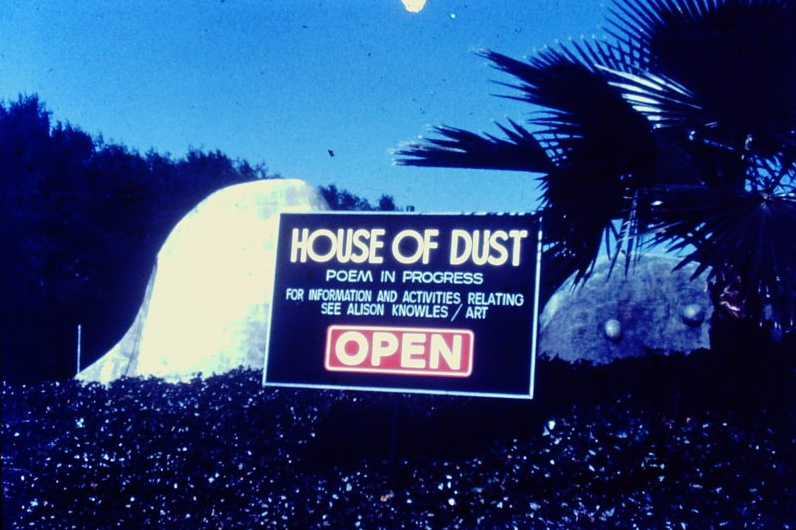

Special thanks to Alison Knowles, Hannah Higgins, Jessica Higgins, Joshua Selman, James Fuentes, Julia Robinson, Christian Xatrec, Norman C. Kaplan, Irene Lotspeich-Phillips, Jenny Tobias, Dorothee Charles, Christopher Lowery, Mark Bloch, Todd Alden, Simone Forti, Michael Bell, Gladys Washburn, Willard van de Bogart, David Eisenman, Jeffrey Perkins, Calvin Miceli-Nelson, Getty Research Institute, Museum of Modern Art, EAI, Lux, Simon Preston, Murray Guy, Esther Schipper, Galerie Fricke, and International Print Center New York. Ph.D. students who contributed texts and organized public programs: Daisy Atterbury, Iris Cushing, Elizabeth Donato, Christopher Green, Alexei Grinenko, Joseph Henry, Debra Lennard, Bess Rowen, Hallie Scott, Gillian Sneed, Kaegan Sparks, Rachel Valinsky, Ian Wallace.
About the exhibition
Alison Knowles’s computerized poem of 1967, The House of Dust and her subsequent built structures of the same name are the focus of this presentation. Documentation of Knowles’s poem and built structures, discussions, publications, and performances are presented in dialogue with other artworks from the period—predominantly by Knowles and other Fluxus artists—exploring the nexus of art, technology and architecture in ways that resonate with The House of Dust. In addition, her prescient yet under-recognized project has been an inspiration for contemporary artists’ and architects’ responsive artworks and spatial interpretations included in the exhibition.Knowles’s The House of Dust is among the earliest computerized poems, consisting of the phrase “a house of” followed by a randomized sequence of 1) a material, 2) a site or situation, a light source, and 3) a category of inhabitants taken from four distinct lists. In 1968, the computer-generated poem was translated into a physical structure when Knowles received a Guggenheim fellowship to build a house in Chelsea, New York. This architecture was later destroyed, restored and moved to Cal Arts Burbank, California, where Knowles was invited to teach in 1970-72. She enjoyed teaching her classes in the House and invited artists to interact with with its open structure by creating new works.
Reactivating the pedagogical model proposed by The House of Dust (and by Fluxus with which Knowles was associated), this project at the James is the outcome of collaboration between artists and scholars in disciplines including art, architecture, poetry, literature, music, computer science, and performance. Over the fall semester, reactivations of Knowles’ workshops will engage students in Social Practice Queens at Queens College and Spitzer School of Architecture, City College as part of their curriculum. The exhibition publication includes texts by Ph.D. students in English, Art History, and Theatre at The Graduate Center connecting their research interests on this project to their dissertation topics.
Artists: Alison Knowles and Ay-o, Chloë Bass, Keren Benbenisty, Jérémie Bennequin, George Brecht, Hugo Brégeau, Marcel Broodthaers, John Cage, Alejandro Cesarco, Jagna Ciuchta, Constant, Jean-Pascal Flavien, Yona Friedman, Mark Geffriaud, Beatrice Gibson, Eugen Gomringer, Dan Graham, Jeff Guess, Geoffrey Hendricks, Dick Higgins, Maria Hupfield, Toshi Ichiyanagi, Norman C. Kaplan, Allan Kaprow, Frederick Kiesler, Nicholas Knight, Katarzyna Krakowiak, Mikko Kuorinki, Theo Lutz, Stephane Mallarmé, Alan Michelson, Yoko Ono, Nam June Paik, Jenny Perlin, Nina Safainia, Carolee Schneeman, Mieko Shiomi, James Tenney, Srdjan Jovanovic Weiss, and Emmett Williams.
Curators: Katherine Carl, Maud Jacquin and Sébastien Pluot.
Co-sponsored by the French Ministry of Culture and the French Institute, the Ph.D. Program in Art History, the Ph.D. Program in Theatre, and the Center for the Humanities, the Graduate Center, CUNY. This project is part of Art by Translation International Research Program in Art and Curatorial Practices directed by Maud Jacquin and Sébastien Pluot at Esba TALM Angers / ENSAPC / CNEAI.